Did the beautiful Nandini, portrayed by Aishwarya Rai, really exist? This article is a friendly guide that you can refer to when you have doubts about the Chola line and want to know which Ponniyin Selvan characters are fictional.
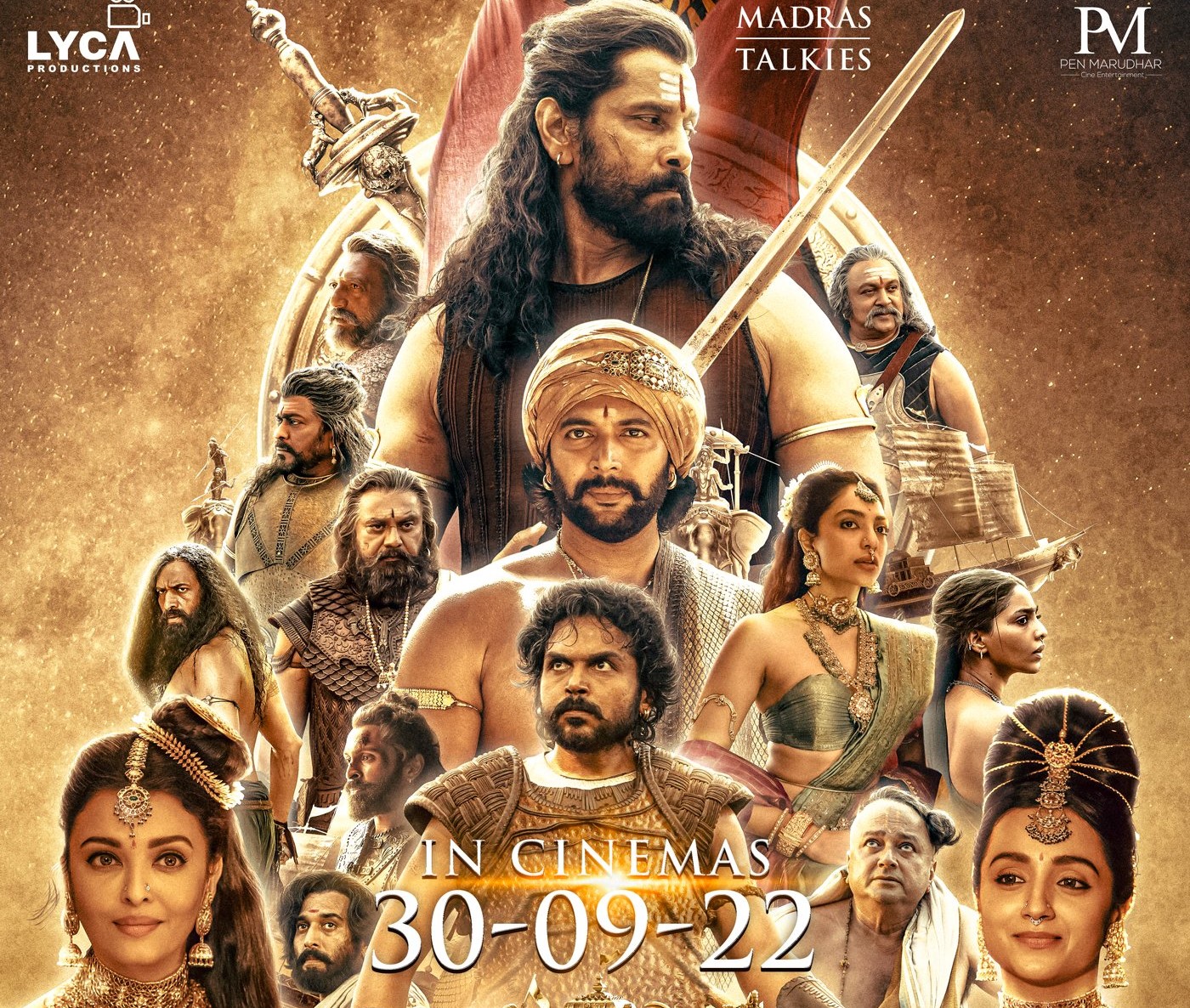
Characters from Ponniyin Selvan 1 (Madras Talkies)
Ponniyin Selvan — the novel on which the Mani Ratnam duology of the same name — is based, revolves around a mysterious death in the Chola royal family.
The novel, authored by Kalki in the 1950s, is set during the time of ruler Sundara Chola (c. 956–973 CE). It also has many references to his Chola ancestors Vijayalaya, Aditya, Rajaditya, and others.
The names and the family line can be confusing if you are relatively new to the Cholas.
This article is a friendly guide that you can refer to when you have doubts about the Chola line and want to know a little bit more about the Ponniyin Selvan characters.
Here is what you can expect in this article on Ponniyin Selvan and the Cholas:
* A clickable list of Raja Raja’s ancestors and some major wars
* Which Ponniyin Selvan characters are fictional, and which ones have some basis in history? Did the beautiful Nandini, now portrayed by Aishwarya Rai in the movie, really exist?
* A brief look at all the imperial Chola kings until Raja Raja Chola
* What do some inscriptions and copper plates say about them and other characters?
* Details about the royal assassination, which remains a mystery even now
* Information about beautiful temples and heritage sites that you can visit even now
Cholas were subordinates under the Pallavas, who ruled the northern part of the Tamil region for centuries.
1) Parakesari Vijayalaya Chola (c. 850-870 CE), the return of the Chola kings
2) Rajakesari Aditya Chola (son of Vijayalaya) (c. 870-907 CE), the devout conqueror
Battle of Thirupurambiyam, c. 879 CE, where the Pallavas (aided by the Western Gangas and Cholas) defeat the Pandyas
Subordinates no longer: Aditya defeats Pallava ruler Aparajitavarman around 890 CE
3) Parakesari Parantaka Chola I (son of Aditya) (c. 907–955 CE), rise and fall
Five kings in 30 years
4) Rajakesari Rajaditya Chola (son of Parantaka I, crown prince but not a king) (c. 935–949 CE), death in a battle
Battle of Takkolam, c. 949 CE, Rashtrakutas defeat Cholas in the battle near Arakkonam, Rajaditya perishes in the war
5) Rajakesari Gandaraditya Chola (son of Parantaka I) (c. 950–956 CE), hymns for the Lord of Thillai
6) Parakesari Arinjaya Chola (son of Parantaka I) (c. 956–957 CE), Raja Raja’s granddad
7) Rajakesari Sundara Chola or Parantaka II (son of Arinjaya) (c. 956–973 CE), expansion again
The events in Ponniyin Selvan take place during his reign
8) Parakesari Aditya Karikala (son of Sundara Chola, crown prince but not a king), the sun who desired to see the heavens (c. 957–969 CE)
9) Parakesari Uttama Chola (son of Gandaraditya and uncle of Raja Raja) (c. 969–987 CE), was he a villain?
10) Rajakesari Raja Raja Chola (son of Sundara Chola) (c. 985–1014 CE), Tirumagal pola…
[The years in brackets are the regnal years of each king, and the approximate numbers are based on the book Colas by the historian KA Nilakanta Sastri. Inscriptions discovered later could have led to a slight change in the regnal years.
Some of them are believed to have been installed as crown princes and co-rulers early during the reign of the previous ruler, hence the overlap in the dates
We also use information from stone inscriptions in temples and copper plates issued by the Chola rulers and others, some of which can still be seen in Madras Egmore Museum]
The Cholas considered themselves descendants of the Solar Race, whose ancestors included Ikshvaku and Sri Rama.
In this line was born Chola. The next two kings according to Chola tradition were Rajakesarivarman and Parakesarivarman.
The Tiruvalangadu copper plates note that these two names (Rajakesari and Parakesari) were since then alternately borne by the Chola kings in the order of their coronation.
The titles, Rajakesari and Parakesari, also helped historians identify the kings, as sometimes their individual names would not be mentioned in the inscriptions.
All information about the Cholas, even the mighty Rajakesari Raja Raja and Parakesari Rajendra, was forgotten till the early 20th century.
This history was pieced together mostly using copper plate inscriptions (such as the Tiruvalangadu copper plates of the Cholas), stone inscriptions in temples, and literary references.
We have epigraphists such as V Venkayya to thank for deciphering the inscriptions and publishing the information in them.
Now we will delve deeper into the novel.
Sembiyan Mahadevi, wife of Gandaraditya Chola, mother of Uttama Chola, and a devout queen (she lived long after the demise of her husband and son, well into Raja Raja’s rule)
Kundavai, elder sister of Raja Raja
Vandiyathevan, the protagonist (Kundavai was one of his wives)
Virapandya, the Pandya ruler beheaded by a Chola crown prince
Krishna III, Rashtrakuta ruler who defeats the Cholas
Vaanavan Mahadevi, wife of Sundara Chola, she committed sati after her husband’s death
Soman Sambavan, Ravidasan: They are mentioned in the Udaiyarkudi inscription as involved in the assassination of a Chola crown prince
‘Anbil’ Aniruddha Bhramarayar, a minister in the Chola court
Boothi Vikramakesari, Kodumbalur ruler and Chola subordinate
Vaanathi, Kodumbalur princess (In the novel, she is the daughter of Boothi Vikramakesari’s brother)
Parthibendravarman, mentioned in inscriptions, sometimes identified as another one of the names of crown prince Aditya Karikalan
Periya and Chinna Pazhuvettaraiyar, part of the Pazhuvur clan, Chola subordinates
Sambuvaraiyar, a Chola subordinate (The plot to install Madurantaka as crown prince in place of Aditya Karikala takes place in his palace in the novel. And someone very important meets a gory end in the same place)
Nathamunigal, the first of the Srivaishnava Acharyas. In Ponniyin Selvan, Vanthiyathevan and Azhwarkadiyan encounter a young Nathamunigal in a Vishnu temple near the Veeranam lake
Nambiyandar Nambi, a Saiva scholar who compiled the thirumurais
Nandini, the daughter of the Pandya king in Ponniyin Selvan and Aditya Karikalan’s ‘beloved’
Poonguzhali, the boatwoman who takes Vanthiyadevan from the Kodiakkarai coast to Lanka, and saves Raja Raja when he falls into the ocean
Senthan Amuthan, devout lad who loves Poonguzhali and … (no spoilers at least here)
Azhwarkadiyan Nambi, a spy employed by Anbil Aniruddhar (the Chola minister)
Kudanthai jothidar, an astrologer in Kumbakonam (Vandiyathevan first meets Kundavai at his place)
During the Sangam age (c. 300 BCE–300 CE), the Cholas were one of the main ruling houses in the Tamil region along with the Cheras and Pandyas.
After that, the Cholas were reduced to a small territory around their capital Uraiyur (a suburb of present-day Tiruchy).
The Pallavas were the main dynasty in Tondaimandalam or the northern Tamil region that includes Kanchipuram and present-day Chennai. South Tamil Nadu was mostly in hands of the Pandya rulers.
Till the time of Vijayalaya Chola, his son Aditya Chola and the battle of Thirupurambiyam. Then the Cholas rose again.
Not as much is known about Vijayalaya as the later Chola rulers. That he conquered Thanjavur (where Raja Raja later built his grand place of worship for Siva, now a UNESCO world heritage monument) and built a temple for the family deity Nisumbasudhini (Durga) there are mentioned in copper plate inscriptions issued later.
Says historian Nilakanta Sastri in his Colas about the conquest of Thanjavur by Vijayalaya from the Mutturaiyars, then the subordinates of the Pandyas:
“Little could the Pallava ruler have suspected that in thus employing his Cola subordinate, he was, as the Indian saying has it, training his tiger-cub to a taste for blood. Nor could Vijayalaya have dreamt that his vicarious victory was to be the beginning of one of the most splendid empires known to Indian history.”
The son of Vijayalaya, Aditya Chola defeated the Pallavas of Kanchipuram and conquered Tondaimandalam, the northern Tamil region. But that came later.
It began with the battle of Thirupurambiyam or Sripurambiyam (c.879 CE), mentioned repeatedly in Ponniyin Selvan. In the novel, the conspiracy to assassinate the Chola crown prince also takes shape in desolate Thirupurambiyam, overgrown with trees and weeds a few decades after the battle.
In this battle, the then mighty empires in the Tamil land, Pallavas and Pandyas, faced off against each other. The Pallavas were helped by their Western Ganga allies. The Western Ganga ruler Prithvipati lost his life in the war. The Cholas were also allies of the Pallavas and could have helped the Pallava ruler Aparajitavarman.
We do not know if Aditya was present in the battle. But in the novel Ponniyin Selvan and likely the film too, an old Vijayalaya, who has to be carried by others, rallies the Pallava-led troops after the death of the Ganga king and plays an important role in the victory.
Soon after the battle of Thirupurambiyam, Aditya defeated his former ally, the Pallava ruler Aparajitavarman (c. 890 CE), and took control of the northern Tamil region.
Temples for Siva, including those mentioned in the Thevaram texts, were already present before Aditya in many places including the north and south banks of Kaveri. But they were mostly made of perishable materials.
Aditya is said to have built temples for Siva along both the banks of the course of River Kaveri (or rebuilt existing temples made of perishable materials using stone) from the Sahayadri mountains to the sea, according to inscriptions.
In addition to the northern Tamil region, Aditya is also said to have conquered Kongunadu (western region). The Gangas of Talakadu (near Mysore) were his subordinates, and he was on good terms with his Chera contemporary.
In the first part of his reign, Parantaka I defeated the Pandyas. Madurai and the entire southern Tamil land came into the possession of Cholas. He also invaded Lanka (Ceylon or Ilam). Hence his title ‘Maduraiyum Ilamum Kondan’.
In addition, he extended the territory in the north from Kalahasti to Nellore.
He initially had to also ward off his brother Kannaradeva, another son of his father Aditya Chola with a Rashtrakuta queen. The Rashtrakuta ruler would have tried to install Kannaradeva as the Chola king.
In the second half of his reign, especially after the death of his ally and Western Ganga ruler Prithvipati II, the position of Parantaka I was weakened as the next monarch of that dynasty allied with the Rashtrakutas.
After the defeat in the battle of Takkolam, about which we will read next, the Cholas lost significant territory in the northern Tamil region. Even in the south, the Pandyas became stronger and so by the end of his reign, the territory under the Cholas had shrunk drastically.
Five kings in 30 years
‘Aanai mel thunjiya devar’ (The prince who lost his life while on the back of an elephant).
This is how inscriptions (and Ponniyin Selvan) refer to the eldest son of Parantaka I. In the novel, this is mentioned repeatedly to illustrate his valour.
Rajaditya led the Chola forces and in c. 949 CE, at the Battle of Takkolam (near Arakkonam in present-day Tamil Nadu), they encountered the troops of the Rashtrakuta Krishna III – Ganga Butuga II alliance.
During the Takkolam battle, an arrow of the Ganga king Butuga II is said to have pierced Rajaditya who was atop an elephant.
The larger Anaimangalam/Leiden copper plate says: “The heroic Rajaditya, the ornament of the solar race, having shaken in battle the unshakable Krishnaraja with his forces, by means of his sharp arrows flying in all directions was himself pierced in his heart while seated on the hack of a large elephant by the sharp arrow of the enemy, and (thus) winning the praise of the three worlds, he ascended to the heaven of heroes in a tall vimana”
The people of present-day Chennai are indebted to Rajaditya. How?
The novel Ponniyin Selvan begins at the vast lake, with the protagonist Vandiyathevan riding alongside in awe of it. The lake owes its existence to Rajaditya.
Rajaditya is said to have asked his troops to dig the lake and named it after his father as Veera Narayana eri. Veera Narayana was one of Parantaka’s titles.
After the death of his elder brother Rajaditya in the Battle of Takkolam, Gandaraditya became the crown prince.
A devout Shiva bhakta, Gandaraditya reigned for a relatively short period after the death of his father Parantaka.
He is believed to be the same Gandaraditya who sang a pathigam (set of 10 songs) on the Lord of Chidambaram (Thillai). It is part of Thiruvisaipa, a text that is in the ninth Saiva thirumurai.
For the English translation of the hymns, click here. The final song, the phalashruti, refers to the author of the verses as the “king of Thanjavur and Kozhi [a reference to Uraiyur, the ancient Chola capital]”. There is also a mention in the eighth song about the king who conquered the southern land (Pandya territory) and Ilam (Lanka), which as we have seen earlier, refers to his father Parantaka I.
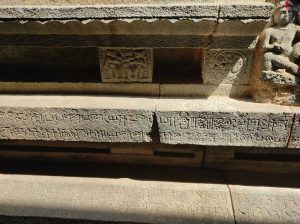
An inscription mentioning the name of Raja Raja Chola in the tomb shrine of Arinjaya Chola near Melpadi in Vellore (Prasanna RS/South First)
The third son of Parantaka I to hold the crown, he reigned for an even shorter period.
Arinjaya, also the grandfather of Raja Raja Chola, is referred to in inscriptions as ‘Arrur tunjiya devar’ (the ruler who lost his life in Arrur).
Arrur was likely somewhere near Melpadi in Vellore, where Arinjaya’s tomb shrine is. He could very well have lost his life in a battle against the Rashtrakutas in a bid to recapture the lost Tondaimandalam territory.
In Melpadi, the Arinjaya tomb shrine or Pallipadai Koil, built by Raja Raja later, is right opposite the bigger Siva temple.
Ponniyin Selvan is set during his reign.
By his time, we find Chola inscriptions again in Tondaimandalam or the northern Tamil region, and the Rashtrakuta inscriptions of Krishna III slowly disappear.
This shows that the Cholas had again expanded their territory to the north.
The ‘Madurakondai Rajakesarivarman’ in inscriptions are believed to be references to him.
Further, it was during his reign that the Pandyas were defeated in the Battle of Chevvur and his eldest son Aditya Karikala beheaded Vira Pandya.
This shows that the Cholas expanded in the southern direction too, but the paucity of inscriptions from this time show that their hold over the south wasn’t strong unlike the north.
Sundara Chola is referred to as ‘Ponmaligai thunjiya devar’, a reference to his death in a golden palace in Kanchipuram in the northern Tamil region.
According to the Tiruvalangadu copper plates, his wife and queen Vaanavan Mahadevi performed sati after his death.
‘Ponniyin Selvan’ Raja Raja Chola is his younger son.
Aditya (sun), one of the important characters of Ponniyin Selvan, we find this constant reference to this son of Sundara Chola:
‘Pandiyan thalai konda Ko Parakesari’ or (The Parakesari who beheaded the Pandya king)
There were doubts on whether this was just a metaphor, a poetic way of describing the victory of Aditya Karikala, believed to have been the crown prince then, over the Pandya king.
Nilakanta Sastri in his Colas writes: “The Thiruvalangadu plates make an express declaration that Aditya II killed Vira Pandya and brought his severed head to the Chola capital. Even here the lateness of the testimony throws suspicion on the event.”
However, this debate can be said to be put to rest by the discovery of the Esalam copper plates much later in 1987.
For instance, historian, archaeologist, and epigraphist R Nagaswamy writes: “Sastri doubted the killing of Vira Pandya and held that the term ‘Pandyan Talai Konda’ should be taken not as killing Pandya, but defeating him in the battle. The present Esalam grant puts an end to this debate by stating that Aditya not only killed Vira Pandya in the battle, but also brought his severed head to Thanjavur and had it exhibited spiked onto a pillar in front of the gate.”
There are also inscriptional references to a Parthibendravarman in the northern Tamil region, who has similar titles including Parakesari and ‘Pandiyan thalai konda’. Nilakanta Sastri in his Colas leans towards the view that Parthibendra was another name for Aditya Karikala, though he points out the existence of an inscription that goes against this.
In Ponniyin Selvan, Pathibendravarman and Aditya Karikala are separate characters, both based in Kanchipuram at the start of the novel.
Coming back to the crown prince’s gruesome act of displaying the severed head of the Pandya ruler (ala the much-reviled boy king Joffrey in the ‘Game of Thrones’), this is believed to have had a role in his assassination.
The Tiruvalangadu copper plate has an eloquent and enigmatic reference to his death: “Aditya disappeared owing to his desire to see heaven.”
We will see more about the murder in the subsection on the Udaiyurkudi temple inscription.
Madurantaka is the son of the devout couple Gandaraditya and Sembiyan Mahadevi. When Gandaraditya died, he was likely an infant, and hence did not succeed him on the throne.
After the assassination of Aditya Karikala, Madurantaka is believed to have taken over as crown prince and then ruler.
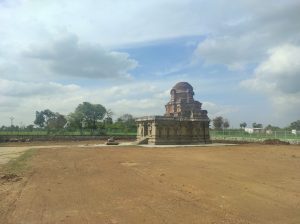
Uttama Chola Eswaram, the temple in Thenneri near Kanchipuram named after her son to which queen Sembiyan Mahadevi has donated (Prasanna RS/South First)
It is interesting that the crown went to Raja Raja’s paternal uncle instead of himself, the younger son of Sundara Chola.
There has always been speculation that Uttama was involved in some way in the assassination of Aditya Karikala, and Ponniyin Selvan resolves this in an interesting way such that the future ruler is not tainted.
Was there civil strife that forced Sundara Chola’s hand and made him appoint Madurantaka Uttama ahead of his son Raja Raja? In Ponniyin Selvan, this is indeed the case and many of the Chola subordinates such as the Pazhuvettaraiyar and Sambuvaraiyar chieftains side with the malleable Madurantaka over Aditya Karikala, who is portrayed as unstable and arrogant.
The Tiruvalangadu copper plates of Raja Raja Chola have this to say: “[Though] requested by the subjects [to occupy the Chola throne], in order to destroy the persistently blinding darkness of the powerful Kali [age], Arunmolivarman who understood the essence of royal conduct, desired not the kingdom for himself even in mind, while his paternal uncle coveted his dominions.”
You are probably already aware of Arulmozhivarman or Raja Raja, one of the most famous of the Chola rulers who built the Rajarajeswaram (now Brihadeeswara or big temple) in the capital Thanjavur.
The son of Sundara Chola is the first of the rulers in the Tamil region to have a meikeerthi detailing his achievements till that point of time as part of stone inscriptions in temples. The most common meikeerthi of Raja Raja begins ‘Tirumagal pola…’
In Ponniyin Selvan, Raja Raja is in Lanka with the Chola army during the time of his father Sundara Chola, and comes back amid various threats to his life. While there is no evidence to suggest that he was in Lanka at that point in time, he did conquer a major part of Ceylon after he ascended to the throne.
Writes Nilakanta Sastri in Colas: “It is probable that Rajaraja signalised the Chola occupation of Ceylon by the construction of a stone temple of Siva in Polonnaruwa. This beautiful little ‘Siva Devale’ constructed of granite and lime-stone which stands within the walled confines of the old city’ of Polonnaruwa is among the few Hindu monuments of Ceylon, which are still in a good state of preservation.”
In Ponniyin Selvan the film, actor Jayam Ravi plays Raja Raja.
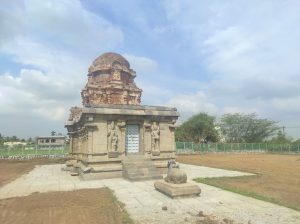
Uttama Chola Eswaram, the temple in Thenneri near Kanchipuram named after her son to which queen Sembiyan Mahadevi has donated (Prasanna RS/South First)
She was the pious queen of the equally pious Gandaraditya Chola. Her son Madurantaka and later king Uttama Chola was most likely an infant when her husband passed away, hence the throne then went to Gandaraditya’s brother Arinjaya.
Sembiyan even survived her son Uttama Chola. She built a number of temples and gave them numerous grants.
One such temple is near Thenneri in Kanchipuram. The earliest inscription it it is from the reign of Raja Raja Chola; the beautiful stone temple named after his predecessor as Uttama Chola Eswaram, to which the latter’s mother and queen Sembiyan Mahadevi has donated, is now protected by the ASI.
There is even a town named after her in the Chola heartland. She is believed to have been held in great esteem by Raja Raja.
Raja Raja is said to have been fond of his elder sister Kundavai, as can be seen from the prominent position he gave to her in this inscription in the Thanjavur big temple. You can still find it in the temple. In Ponniyin Selvan too, they are portrayed as extremely close.
‘Sree Rajarajeswaramudayurukku naam koduthanavum akkan koduthanavum nam pendugal koduthanavum…’
‘What I gave to the Lord of Rajarajeswaram (now called the Thanjavur Brihadeesvara or big temple), what my elder sister gave, what my wives gave …’
Raja Raja also named his daughter Kundavai.
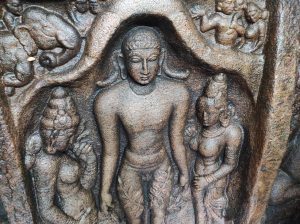
A rock-cut Jain sculpture near Kundavai Jinalayam in Thirumalai hills, Vellore (Prasanna RS/South First)
The princess Kundavai too, like Sembiyan Mahadevi, contributed a lot to places of worship. She built temples for Saivites, Vaishnavites, and Jains in Rajarajapuram, now called Dadapuram (near Tindivanam).
While the Jain temple in Dadapuram is not present anymore, we still have the Kundavai Jinalayam in Tirumalai hills in Vellore, an ASI protected monument.
She was married to Vanthiyathevan Vallavaraiyan, turned by Kalki into the chief protagonist of Ponniyin Selvan.
He was a feudatory of the Cholas and is described as the chief of the Samantas of Raja Raja. His ancestry is not clear and perhaps he was related to the Rashtrakutas.
He was responsible for a part of the area in the Brahmadesam near the erstwhile North Arcot district.
Ponniyin Selvan portrays the epic romance between Kundavai and Vanthiyathevan.
In reality, Kundavai was just one of his wives.
Nilakanta Sastri in Colas writes: “Two other wives of this person are mentioned, Indaladevi and Mandaragauravanar Kundadeviyar, who, despite the second part of her name, appears to have been different from Parantakan Kundavai Pirattiyar, the Cola princess said to have been residing in the palace at Palaiyarai in the fourth and fifth years of the reign”.
Boothi Vikramakesari was the Irrukevel chief of Kodumbalur, long-term allies/feudatories of the Cholas.
The foundation inscription of the beautiful Moovar Koil in Kodumbalur says that the three temples were built by Vikramakesari on behalf of himself and his wives Karrali and Varaguna. The two remaining temples are protected by the ASI.
In Ponniyin Selvan, Vaanathi is the orphaned daughter of Vikramakesari’s brother. The Kodumbalur princess would marry Raja Raja Chola and was one of his wives.
“Pandiyanai talaikonda Karikala Chozhanai kondru drogigalana Soman … thambi Ravidasanana Panchavan Brahmaadirajanum…” or
“Those who killed [Aditya] Karikala Chola, who beheaded Virapandya, and became traitors — Soman, younger brother Ravidasan alias Panachavan Brahmaadirajan …”
This is the only inscription that gives us some details about those involved in the assassination of Aditya Karikala. It is in the Anantheesvaram temple in Udayarkudi near Veeranam lake.
One of the reasons Nilakanta Sastri suspects Uttama Chola of involvement in the assassination is because this inscription is from the second year of the reign of Raja Raja. So he surmises that no action was taken against the culprits during the rule of his predecessor Uttama Chola.
However, the historian Kudavoiyal Balasubramanian notes that this is a misinterpretation and the punishment could very well have been meted out earlier. He says that this is not the royal order of the punishment given to those involved but is only about the selling of the lands confiscated from the culprits who had fled and their relatives. So Uttama Chola might not have been involved in the crime after all.
Further, Panchavan Brahmaadirajan is a Pandya title and this indicates the assassination could have been revenge for Aditya Karikalan’s macabre act of carrying Virapandya’s head to the Chola capital and displaying it on a spike there.
They were subordinates who helped the Chola rulers since at least the time of Parantaka I.
Administering the areas around Kizhapazhuvur and Melapazhuvur under the Chola ruler, they were closely allied to the ruling family with a Pazhuvur princess marrying Parantaka I.
In Ponniyin Selvan, they side with Madurantaka Chola and want him to replace the impetuous Aditya Karikala as crown prince.
In the movie, veteran actors Sarathkumar and Parthiban play the Pazhuvettaraiyar brothers, Periya Pazhuvettaraiyar and Chinna Pazhuvettaraiyar.

Jul 26, 2024

Jul 26, 2024

Jul 24, 2024

Jul 24, 2024

Jul 22, 2024

Jul 22, 2024